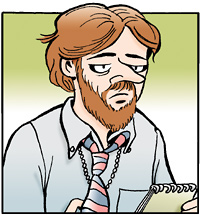Into the perfect storm of Internet competition, spiraling newsprint costs and the decline of classified advertising has come a fourth factor: probable worldwide recession. It couldn’t happen at a worse time for the beleaguered newspaper industry.
Newspaper advertising revenue is expected to decline a record 11.5% to $40.1 billion this year, the Newspaper Association of America says. The organization does see light at the end of the tunnel; it’s predicting that the nosedive will level off a bit in 2009. But such forecasts should probably be taken with a grain of salt, considering that no one knows the full extent of the current financial crisis or the likelihood that worldwide government interventions will succeed. Also consider, at Tim Windsor points out in a comment on the E&P blog, that the NAA initially forecast just a 1.2% decline in business this year.
The 11.5% revenue drop would be the largest the association has seen since it started tracking results 58 years ago, and it reflects the continuing collapse of the classified advertising market at the hands of Craigslist et. al. In fact, the NAA expects classified revenues to fall from $14.1 billion in 2007 to just $9.4 billion in 2009, a 33% crash in a business that is already off by 50% from its peak. Retail advertising is expected to decline about 10% and national advertising should drop 13% in the same time period. Online revenue won’t pick up much of the slack: the NAA forecasts meager growth of 1.8% this year.
Media Life magazine catches up with David T. Clark, senior research analyst for publishing and advertising at Deutsche Bank Securities, to get his take on the wreckage. Here are a few quotes:
“This is a pivotal time for the newspaper-retailer relationship…Share losses now will be amplified when we emerge from this downturn.”
“Newspapers must be perceived as a marketplace in which the advertising is considered content, not clutter.”
“I think we’ve got at least several more quarters of very steep industry ad revenue declines to go before we see much improvement.”
“Newspapers do digital pretty well, but…it doesn’t look like a viable business model will emerge in time to save some metro dailies…They are at the bleeding edge of the structural issues the industry faces…Metro papers over-index to classified advertising, which is disappearing fast….They need to variabilize as much of their costs as possible, get all of that old media hardware off of the balance sheet…Tough to sell a printing press these days, though.”
Desert Storm
The East Valley Tribune of Mesa, Ariz. will make massive cutbacks, laying off 142 people, or about 40% of its staff. The daily will also withdraw coverage from nearby Scottsdale and Tempe and scale back to four days a week, most likely Wednesday, Friday, Saturday and Sunday. The print format will also be scaled back to two sections ‑ one for local news and one for sports, entertainment and late-breaking news.The Tribune has a paid and free distribution of around 100,000. It’s owned by Freedom Communications, a publisher of more than 100 mostly small newspapers and a few big ones, including the Orange County Register. Ray Stern analyzes the impact on the valley, including the huge loss the cutbacks represent to the city of Scottsdale, which may become the US’ largest major metro area without a daily newspaper.He also lists some of the prominent journalists who will be exiting the scene.
Spokane Spokesman-Review Girds for More Cuts
The Spokane Spokesman-Review, whose editor quit last week over cutbacks in his staff, named Gary Graham to the post. Publisher W. Stacey Cowles took some questions from staffers and offered little optimism about the immediate future. His responses are noted on a staff blog. Highlights:
- The S-R “is planning for the possibility of not having” the Associates Press in the future.
- Potential cost-cutting measures include a reduction in trim size reduction (next June), dropping some circulation routes in outlying areas, reconfiguring press runs and office space consolidation. The paper is likely to close its Spokane Valley bureau.
- “The company would like more flexibility in compensation of newsroom employees, more flexibility to change compensation to reflect market rates.” In other words, pay cuts are likely.
Tumbleweeds in Albany
The New York Times writes of the impact of staff cuts on the press corps covering goings-on in Albany. With the closure of the New York Sun last week, five newspapers have exited the state capitol in less than two years. The organization of statehouse journalists in Albany has seen its ranks dwindle from 59 members in 1981 to 42 journalists last year. “With the exception of Buffalo, Watertown and Albany itself, no city outside the New York metropolitan area has a newspaper with a dedicated, full-time correspondent in the Capitol,” writes Jeremy Peters. Wire-service bureau reporters don’t offer the local angle that correspondents used to provide. Reporters who once jostled for desk space now have their pick. “It’s like tumbleweed should be blowing around here,” says one reporter. Observers fret that the cutbacks are leaving legislators to play in their own private sandbox withoutthe limits of citizen oversight.
Layoff Log
- More cutbacks at the Los Angeles Times. LA Observed is reporting that the paper will cut 75 positions, which would bring total newsroom staffing to about 650. That’s down from a high of nearly 1,200 in 2001. The reductions will be achieved through buyouts, if possible, but staffers will be told that this round of cutbaks will be their last chance to get a package of two weeks’ pay for each year of service. Media Bisto says the Washington bureau will be cut back right after the election. American Thinker comments“More and more unemployed left wing journalists are joining the sans culottes. History teaches us that unemployed intellectuals are fodder for revolutionary movements.” (via Edward Padgett)
- The Cleveland Plain Dealer plans to cut 38 unionized newsroom jobs, or about 13 percent of the newsroom’s staff. Most of the jobs being eliminated are held by Guild members. Employees have until Nov. 20 to accept a buyout offer, with layoffs expected to make up the difference. The Plain Dealer, which has 299 newsroom employees, cut 64 journalist jobs in 2006. The actual reductions are somewhat below the rumors of 20% cutbacks that circulated in June.
- Boulder’s Daily Camera is moving all of its remaining printing and packaging operations from Boulder to Denver and laying off 29 more workers by the end of October.The paper will now be printed at the Denver Newspaper Agency facilities, where the Denver Post and the Rocky Mountain News have recently taken up residence.
And Finally…
 The industry downturn has claimed one of the world’s most famous journalists – and he isn’t even a real person. Rick Redfern, the resident ink-stained wretch of the Doonesbury comic strip for more than 30 years, has decided to accept a buyout. “Redfern leaves with utter resignation, apparently having reasoned that he has no real newsroom options,” writes The Washington Post‘s Michael Cavna. “Thanks for the 30-plus years, Rick. By the fourth panel — in the style of a true newspaperman — you always had the perfect line.”
The industry downturn has claimed one of the world’s most famous journalists – and he isn’t even a real person. Rick Redfern, the resident ink-stained wretch of the Doonesbury comic strip for more than 30 years, has decided to accept a buyout. “Redfern leaves with utter resignation, apparently having reasoned that he has no real newsroom options,” writes The Washington Post‘s Michael Cavna. “Thanks for the 30-plus years, Rick. By the fourth panel — in the style of a true newspaperman — you always had the perfect line.”



